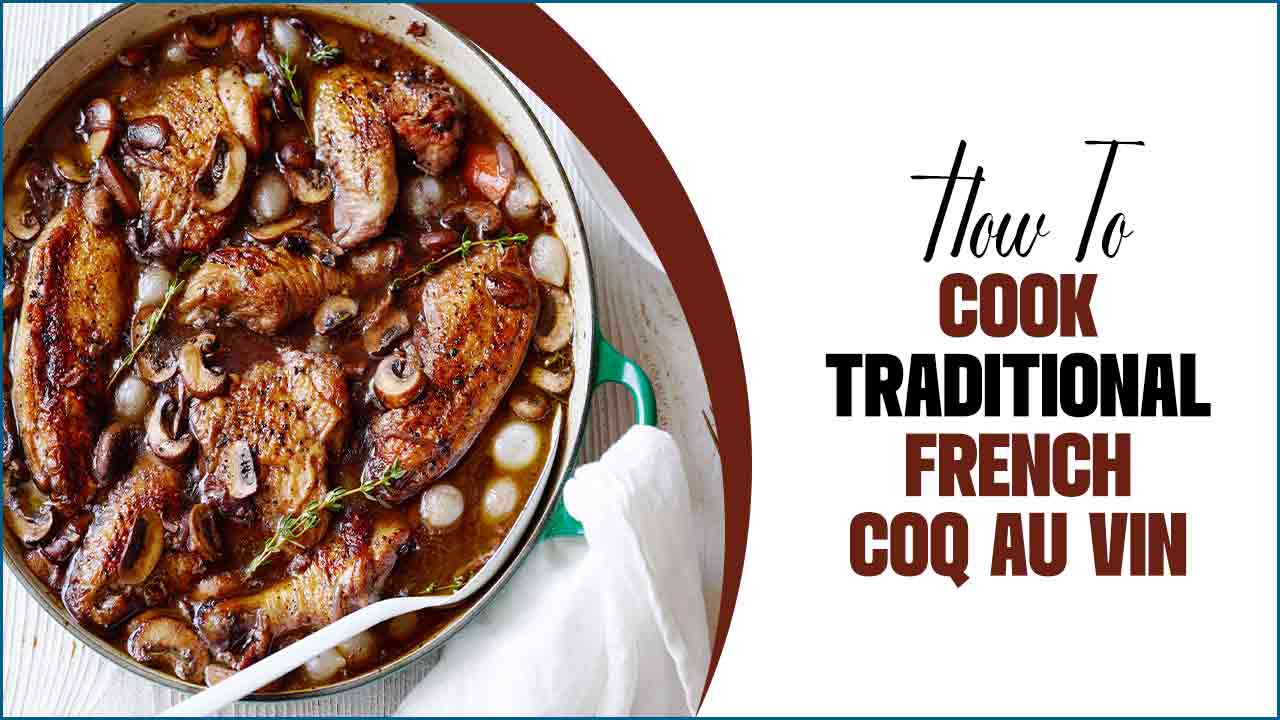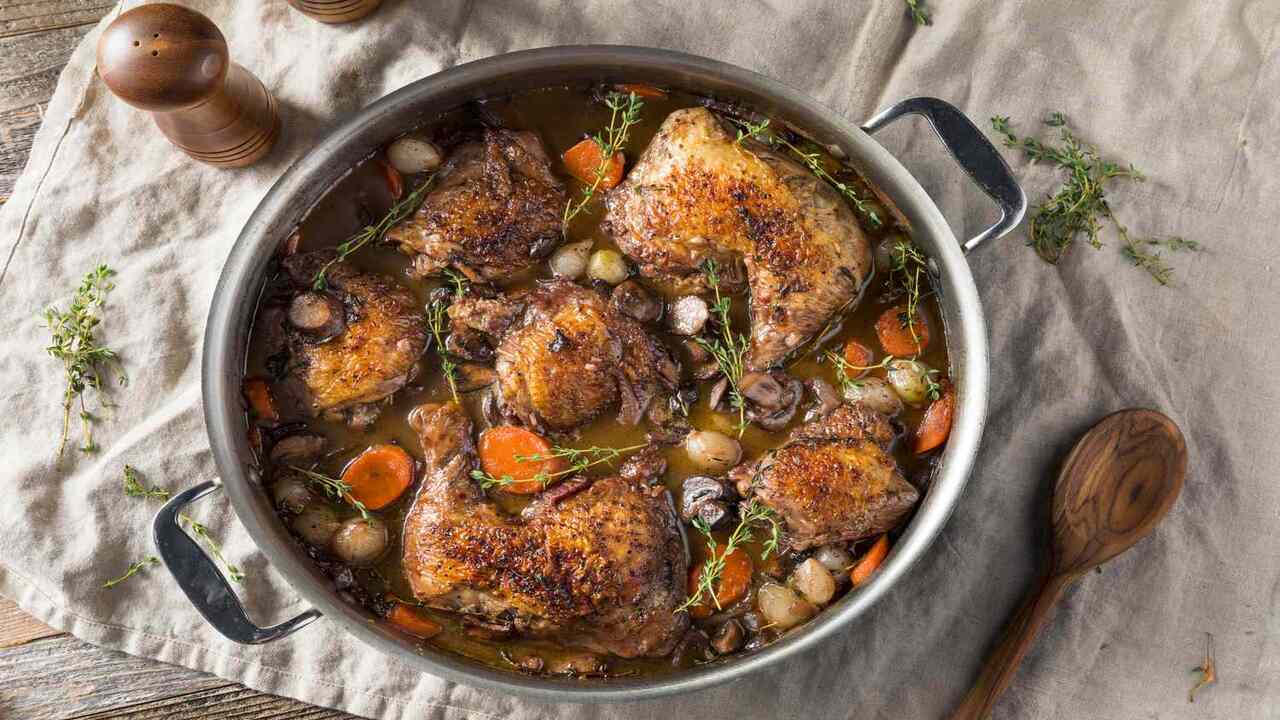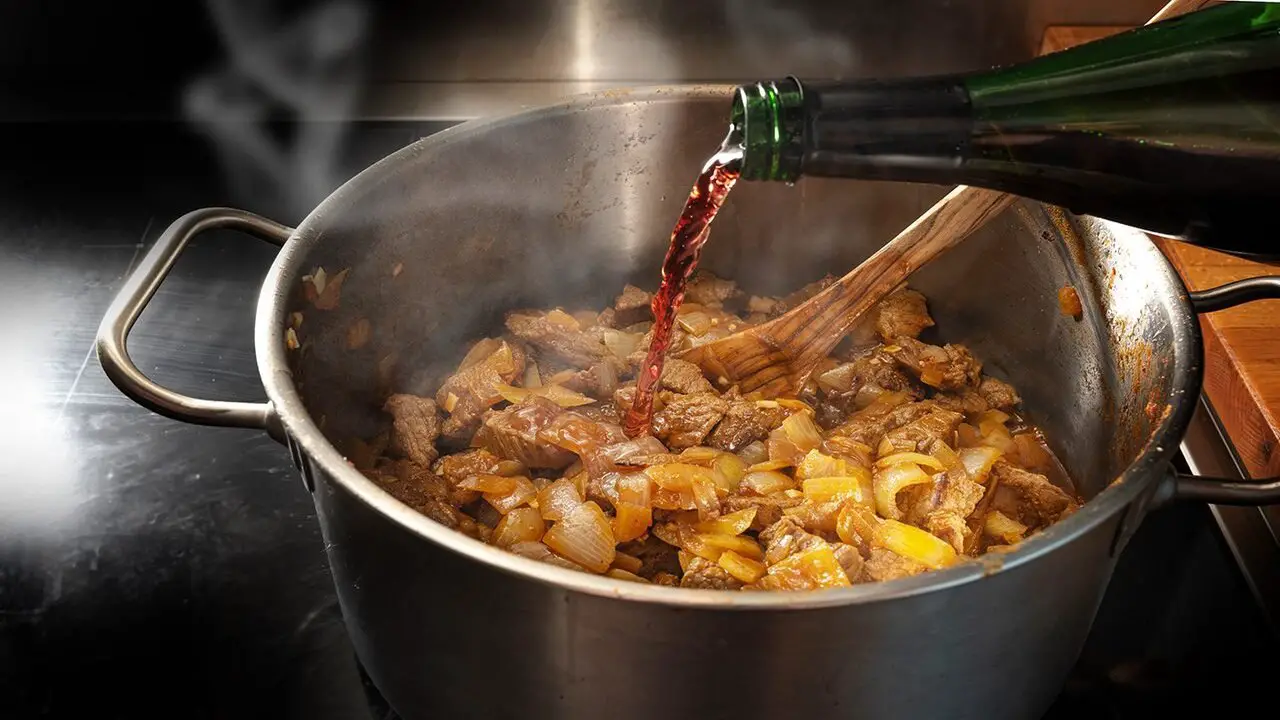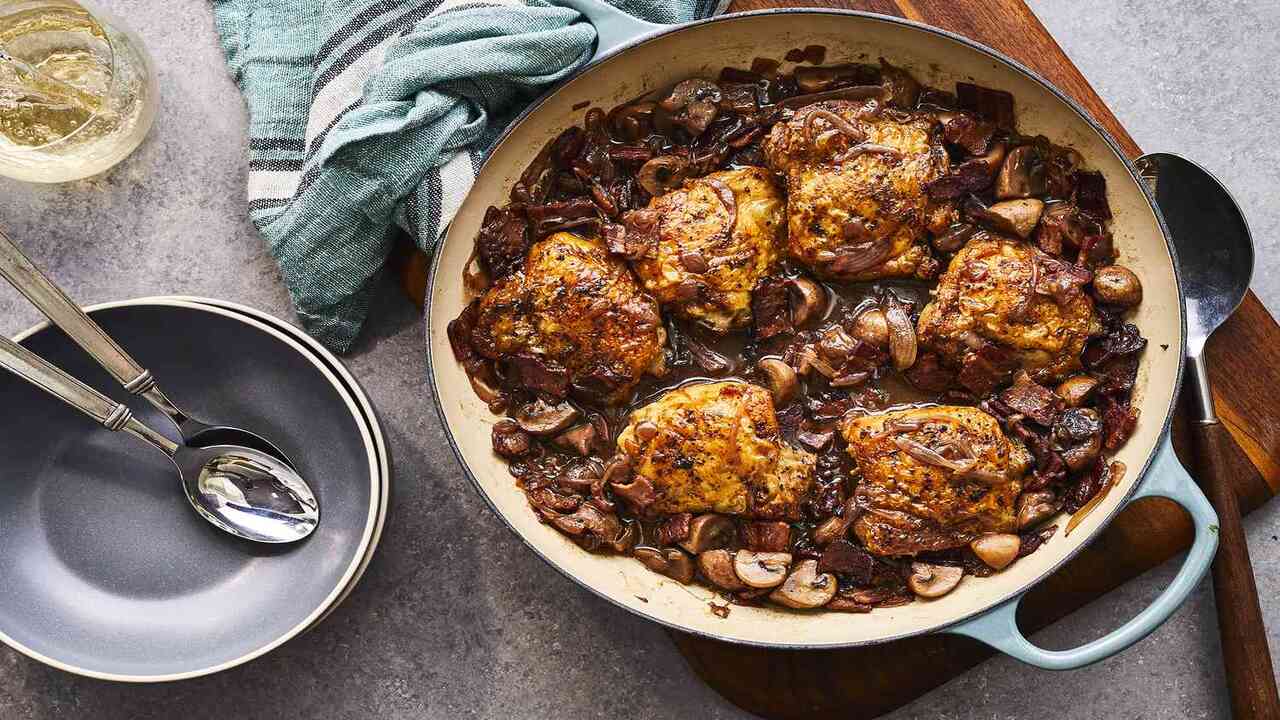Coq au Vin is a classic French dish known for its rich flavors and tender chicken. This traditional dish is made by braising chicken in red wine, bacon, mushrooms, onions, and herbs.
The result is a hearty and delicious meal perfect for special occasions or cozy nights at home. While it may sound complex, cooking Coq au Vin can be a rewarding experience for any home cook. We will guide you through the step-by-step process of how to cook traditional french coq au vin, sharing tips and tricks along the way.
From marinating the chicken to choosing the right wine for that perfect flavor infusion, we’ve got you covered. We’ll also delve into the secrets of achieving tender meat and a rich, aromatic sauce.

How To Cook Traditional French Coq Au Vin: Tips For Recipe

Cooking traditional French Coq au Vin is a labour of love that requires time and attention to detail. This classic dish features chicken slowly simmered in red wine, mushrooms, onions, bacon, and aromatic herbs.
The key to achieving the rich, savory flavors of Coq au Vin is to use quality ingredients and allow the dish to cook for several hours slowly. Marinating the chicken overnight in red wine helps to infuse it with flavor and tenderize the meat.
However, Cooking traditional French Coq au Vin requires attention to detail and a few key tips to ensure a delicious result. Here are some tips to help you perfect your recipe.
By following these tips on how to cook traditional french coq au vin, you can create a delicious and authentic French Coq au Vin that will impress your family and friends. Bon appétit
Marinate Chicken For Tenderness

To achieve the perfect tenderness and flavor in your Classic Coq au Vin, marinating the chicken is a crucial step. Start by choosing a quality red wine you enjoy, like Pinot Noir or Burgundy.
In a large bowl, combine the chicken with the wine and onions, garlic, carrots, and aromatic herbs such as thyme and bay leaves. Let the chicken marinate for a few hours or overnight in the fridge, allowing the flavors to penetrate the meat.
Before cooking, take the chicken out of the marinade and pat it dry for even browning. This will result in a succulent and flavoursome dish that captures the essence of French cuisine.
Use Quality Wine For Flavor

The dish’s flavour relies on top-notch wine when cooking a traditional French Coq au Vin. Opt for a premium red wine like Burgundy or Pinot Noir to enhance all the delicious flavors.
Avoid inexpensive or cooking wines, as they can interfere with the taste. In cooking, incorporate the wine to let the flavors blend seamlessly while the dish simmers. Ensure you’re using a wine you’d enjoy drinking to savor the richness of your Coq au Vin.
Sear Chicken For Caramelization
Searing the chicken before braising it in the wine is crucial in cooking traditional French Coq au Vin. This process helps develop a rich caramelized flavor in the dish. Begin by heating a large skillet or Dutch oven over medium-high heat and adding oil or butter.
Pat the chicken dry with paper towels and season it with salt and pepper. Once the skillet is hot, place the chicken, skin side down, and cook until it becomes browned and crispy, which usually takes 5-7 minutes.
Flip the chicken over and brown the other side for 5-7 minutes. This step ensures that the chicken is beautifully browned and adds depth to the overall flavor profile of the Coq au Vin recipe.
Use Bacon For Added Flavor

Bacon is a key ingredient in elevating the flavor profile of the classic French dish, Coq au Vin. For added richness and a hint of smokiness, cook crispy bacon in a large Dutch oven or heavy-bottomed pot. As the bacon renders its fat, this becomes the flavorful base of the dish.
Proceed to brown the chicken pieces in the luscious bacon fat, creating depth and complexity in each bite. Incorporating bacon in your Coq au Vin adds a touch of indulgence that perfectly complements the other savory elements. The bacon-infused flavors will leave you wanting more from the first bite to the last.
Simmer In Stock For Richness
Simmering the chicken in stock is crucial in preparing the classic French Coq au Vin. This traditional recipe involves braising the chicken in a flavorful mixture of red wine and chicken stock.
The simmering process allows the chicken to absorb the richness of the stock, resulting in a succulent and mouthwatering dish. It’s important to use high-quality chicken stock, whether homemade or store-bought, to enhance the overall taste of the Coq au Vin.
Ensure that the chicken is completely submerged in the stock and let it gently simmer over low heat to develop its full flavor potential. This slow-cooking method creates a luxurious sauce that perfectly complements the tender chicken.
Use Boiler Onions For Sweetness
When preparing the classic French dish Coq au Vin, a key tip for enhancing the flavor is to use boiler onions instead of regular ones. Boiler onions, known for their smaller size and sweeter taste, add a delightful touch of sweetness to the dish.
To incorporate them into your recipe, peel the boiler onions and include them in the pot with the other vegetables and chicken. Their natural sweetness will beautifully balance the richness of the red wine, resulting in a truly delectable flavor.
Add Herbs For Aroma
To enhance the aroma and elevate the flavor of your Coq au Vin, incorporate fragrant herbs such as thyme, bay leaves, and parsley. These traditional French herbs infuse the dish with a delightful earthiness, perfectly complementing the richness of the red wine and chicken.
Whether opting for fresh or dried options, adding these herbs during cooking is essential or tying them together in a bouquet garni for effortless removal later on. This simple addition allows you to experiment and create a harmonious blend of flavors, turning your Coq au Vin into an unforgettable culinary masterpiece.
Serve With Crusty Bread For Sopping Up Sauce

When serving Coq au Vin, don’t forget the crusty bread. This classic French dish, consisting of chicken, red wine, and various aromatic ingredients, calls for a side up to the task of sopping up its rich and flavorful sauce.
A fresh baguette or rustic bread is ideal for this purpose. With every bite, you’ll experience the delightful union of the savory sauce and the bread’s crispy exterior. So, when cooking Coq au Vin, have some crusty bread on hand to complement and enhance the overall dining experience.
Preparation Tips To Cook Traditional French Coq Au Vin
To prepare the traditional French Coq au Vin recipe, there are a few key tips that you should keep in mind. Begin by marinating the chicken in a flavorful red wine marinade overnight. This will help enhance the taste and tenderness of the chicken.
Opt for a high-quality red wine, such as a rich Burgundy or Pinot Noir, for the best results. While cooking, use a Dutch oven or a large skillet to simmer the chicken in the marinade over low heat. This slow cooking process allows the flavors to develop and the chicken to become tender.
To add depth of flavor, include ingredients such as onions, carrots, garlic, and mushrooms. These ingredients complement the chicken and add richness to the dish. Consider pairing Coq au Vin with crusty bread or mashed potatoes when serving it.
These side dishes work wonders in soaking up the delicious wine sauce and offer a delightful contrast in texture. The combination of the savory chicken, aromatic wine sauce, and crusty bread or creamy potatoes creates a symphony of flavors that is sure to impress your taste buds.
Cooking Time
When cooking traditional French Coq au Vin, cooking time is crucial in achieving the perfect flavors and tenderness. This classic coq au vin recipe requires slow cooking to allow the rich flavors of red wine, onions, mushrooms, and herbs like thyme and bay leaf to infuse into the chicken.
Simmering the stew for at least 2 hours is recommended, but for even more intense flavours, you can let it cook for up to 4 hours on medium-low heat. The long cooking time at a gentle simmer ensures the chicken becomes tender and succulent while allowing the flavors to meld together beautifully.
To serve this French delicacy, have a fresh baguette or rustic bread to soak up the delicious wine sauce. The combination of the savory chicken, flavorful wine sauce, and crusty bread is a true delight.
Serving Tips
When serving the Coq au Vin recipe, it’s all about the perfect accompaniments. A crusty bread or a side of cooked potatoes is ideal for sopping up the sumptuous wine sauce and elevating the flavors. Don’t forget to pour a glass of Burgundy or Pinot Noir wine to enhance the dining experience.
Garnish with a sprinkle of fresh thyme or parsley for a touch of freshness and vibrant colour. To complete the meal, serve with roasted vegetables or a refreshing green salad. And remember, the leftovers are even more delicious the next day, so don’t hesitate to refrigerate and enjoy them later.
Tips For Storing And Reheating Coq Au Vin

Follow these helpful tips to store and reheat your delectable French Coq au Vin. Once you’ve prepared the dish, transfer any leftovers to an airtight container and refrigerate for up to 3 days.
When it’s time to reheat, gently warm the Coq au Vin over a low heat setting on your stovetop. Stir occasionally to ensure even reheating. If the sauce has thickened during storage, add a splash of chicken stock or red wine to thin it out while warming it up. Remember to bring your Coq au Vin back to a simmer before serving.
Conclusion
Cooking traditional French Coq au Vin is a labour of love that requires time and attention to detail. This classic dish showcases French culinary techniques from marinating the chicken in red wine and aromatic herbs to slowly braising it until tender.
The rich flavors of the wine-infused sauce and the succulent chicken and earthy mushrooms create a comforting and elegant dish. Whether you’re hosting a dinner party or simply want to treat yourself to a taste of France, mastering the art of Coq au Vin will impress your guests and leave them craving more.
So don your apron, pour yourself a glass of wine, and prepare to embark on a culinary journey through the heart of France. We hope now you understand how to cook traditional french coq au vin.
Frequently Asked Questions
1.What Is Traditionally Served With Coq Au Vin?
Ans: Coq au vin traditionally accompanies crusty French bread or creamy mashed potatoes. Buttered noodles or rice are also popular choices. Complement the dish with a glass of red wine like Burgundy or Pinot Noir, and consider serving it alongside a side salad or steamed vegetables for a well-rounded meal.
2.What Is The Best Cooking Wine For Coq Au Vin?
Ans: The ideal cooking wine for coq au vin is a red wine like Burgundy or Pinot Noir. It should have a balanced flavor and acidity to enhance the dish without overpowering it. Choose a wine you enjoy drinking, avoiding overly sweet or heavily oaked options.
3.Should I Remove The Skin From Chicken Coq Au Vin?
Ans: It is up to personal preference whether to remove the skin from chicken coq au vin. Leaving the skin on can enhance flavor and moisture, while removing it can result in a lighter dish. Consider your dietary preferences and desired outcome when deciding whether to remove the skin.
4.Is Coq Au Vin Better With Red Or White Wine?
Ans: Coq au Vin is traditionally prepared with red wine; its rich flavors complement the dish. However, you can try using white wine for a lighter twist. The choice between red and white wine ultimately comes down to personal preference and the flavor profile you want to achieve.
5.What Is The Best Type Of Wine To Use In Coq Au Vin?
Ans: For Coq au Vin, the best wine to use is a dry red wine like Burgundy or Pinot Noir. It should be full-bodied with balanced acidity and tannins. Avoid sweet or fruity wines that may not complement the dish’s flavors. Choose a wine you enjoy drinking, as its flavor will infuse into the dish.

I’m a writer and blogger who loves to talk about entertainment, culture, and relationships. I love to share my thoughts and insights on these topics, and I’m always looking for new ways to engage with my readers. I’m also a big fan of learning new things, so I’m always exploring new areas of interest.





